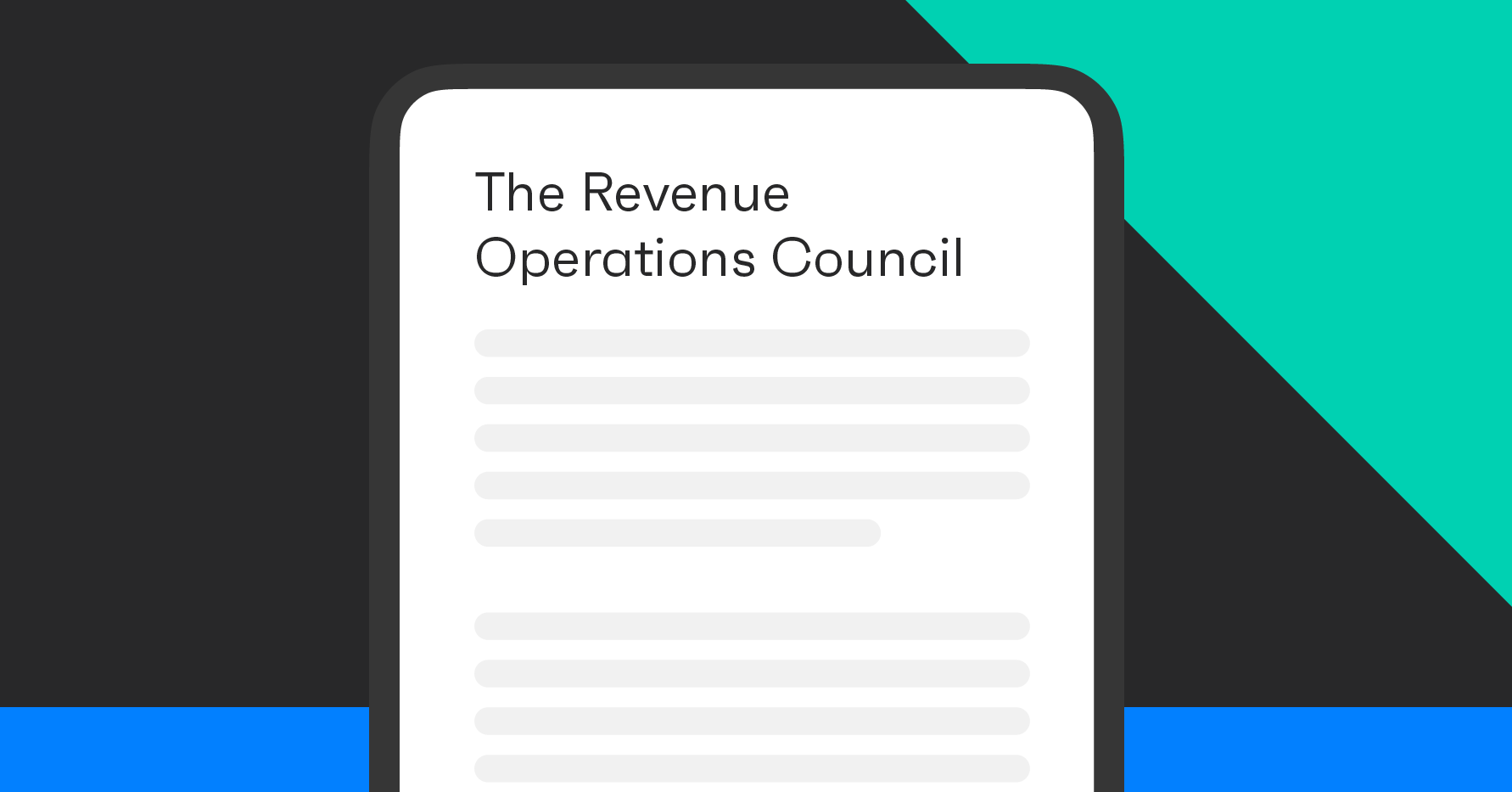Every company’s revenue process is composed of key moments in time, such as one-on-one meetings, forecast calls, quarterly business reviews (QBRs), and board meetings. Taken together as a series of events, these critical junctures are known as your revenue operating cadence.
Time spent in aimless meetings compounds, resulting in less productivity and, eventually, stunted company growth. That’s why developing an effective meeting cadence is critical. A solid revenue operating cadence makes the most of your team’s limited time, keeping everyone focused on the information and actions that grow revenue. And it’s revenue operations leaders’ job to prioritize the touchpoints that matter.
So which meetings matter? The ones that propel your revenue team toward your strategic revenue goals, which could be going public, entering new markets, or growing via mergers and acquisitions.
Reinforce your strategic goals with a revenue operating cadence
Cadences are the glue that connect your revenue team’s daily actions to your company’s overall strategy. Achieving your goals requires the continuous reinforcement that cadences deliver. If you’re not talking about your larger strategy, that strategy won’t stick. Ultimately, your cadence determines your growth.
At the helm of those cadences are RevOps leaders. I think of revenue operations leaders as part chief of staff, part chief operating officer for the executives they support, such as the chief revenue officer. As RevOps professionals, we run the command center operating cadences, and it’s a strategic role to outline the events that drive your entire company toward success.
Leaders on the Revenue Operations Council know this well, as a group of experts who provide market education to the global revenue operations community. In the research paper, “Upleveling Your Revenue Operating Cadence and Communication,” ROC members from Zoom, Okta, Qulatrics, and Alteryx share how they built effective cadences that fuel consistent growth.
I’ve distilled some key learnings from the paper into three steps that can optimize your RevOps program:
- Start small, then expand your cadence over time.
- Schedule the meetings that matter, then make them meaningful.
- Layer in communication structures built for collaboration.
1. Start small, then expand your cadence over time
Introducing or refining your revenue operating cadence doesn’t have to happen all at once, and it doesn’t have to be disruptive. It shouldn’t be, considering that your cadence has a profound effect on your company’s growth.
Instead, updating your cadence can be a gradual shift that eases teams into improved processes over time. A benefit of starting small is that you gain more room to test changes, see what’s working, what’s not working, and adapt slowly.
Of course, every company has a cadence, whether or not they’ve intentionally established one. As a RevOps leader, you’re probably not building a net-new cadence from scratch. Rather, you’re probably evaluating existing meetings and milestones to determine how they fit into a more strategic, intentional cadence. In practice, this can look like keeping some previously established standing meetings and potentially phasing them out over time as your cadence matures.
To get started, many organizations outline a weekly or bi-weekly cadence, rather than creating a larger-scale monthly, quarterly, or annual cadence. This way, RevOps leaders can test the waters on a smaller scale to gauge how their team responds to the update, and get ahead of any process gaps.
Cody Guymon, COO of global sales at Qualtrics and an ROC member, recommends this approach because, as it turns out, starting with a shorter cadence can help you plan ahead.
“Start a bi-weekly cadence, bringing the formal or informal revenue operations key stakeholders together to assess the current and future quarters’ needs of your organization,” says Guymon.
2. Schedule the meetings that matter, then make them meaningful
Your revenue team has limited time. They should spend most of it on engaging with prospects and customers to advance deals, not mired in process meetings. As you develop your organization’s cadence, it’s important to think about leveraging everyone’s time wisely.
A well-designed cadence removes meaningless meetings, like recurring superfluous check-ins, and prioritizes meetings that make a difference.
Cadences should be structured, yet flexible enough to allow room for adjustments as your organization’s priorities change and as business conditions evolve. Having an agile cadence also means that you can bubble up new information in real time to keep everyone on your team up-to-date and on the same page.
Bottom line: Make your meetings count. Ways to do that include:
- Proactively getting internal buy-in on your operating cadence.
- Creating clear agendas for each meeting to appropriately set expectations.
- Designating KPIs and their data sources ahead of time to gain early alignment.
Alignment on data is especially critical because it opens the door to better, more strategic conversations during your cadence. All participants should review the shared data from previously agreed-upon sources to ensure every meeting focuses on your path forward.
Prioritizing the actions that will happen next, and between your cadences, is key. The best meetings go beyond simply discussing data and instead use analytics to glean insights that inform smarter business decisions.
Phillip Jones, Alteryx’s VP of sales operations and ROC member, has seen the impact of data-driven insights for himself and for the company’s sales managers.
“Equipping managers with real-time insights is very powerful. It enables data-driven coaching sessions and conversations,” says Jones. “Every company expects their reps to be focused, productive, and meeting performance expectations. Managers must have real-time insights to help make this happen.”
3. Layer in communication structures built for collaboration
Cadences and communication work in tandem to drive revenue teams toward business growth. Of course, that relationship becomes more complex as your business grows. High-growth companies demand processes that allow them to onboard new reps quickly, while also building a foundation for each individual’s long-term success.
Zoom, the video communications tech company that went public in 2019 and saw hypergrowth during the COVID-19 pandemic, is a prime example of a top company that solves complexity with process. Hilary Headlee, Zoom’s head of global sales operations and enablement, and an ROC member, notes that process backs everything—especially in rapid growth environments.
“Trying to teach our team where to access all of the information they need can be tricky,” says Headlee. “The unprecedented demand we’ve seen at Zoom really increased the amount of questions that we got. Sometimes, they just needed an answer to a quick question, so they didn't want to issue a ticket or go through our CRM.”
Communication that occurs between your cadences is crucial because it helps the entire revenue team stay on track and focused throughout the full 12-week quarter and four-quarter year. With this in mind, RevOps leaders can develop solutions to ensure teams always know where to get the information they need before, during, and after every meeting.
“At Zoom, we needed to illustrate where our team members could locate key information,” says Headlee. “We created a unified way for our reps to get the information they needed. We call it our CARE framework.”
The CARE model was originally developed by Headlee’s team at Zoom. It illustrates where team members can receive internal CARE, or:
- Check for key information.
- Ask questions about information.
- Request updates or changes to information.
- Escalate issues with any information.
Below is a brief example of what a CARE matrix such as Zoom’s looks like:
|
Team |
Check |
Ask |
Request |
Escalate |
|
Order management |
Internal intranet |
Chat platform (instant message) |
Workflow technology |
|
|
Deal desk |
Internal intranet |
|
Workflow technology |
|
Ultimately, your progress depends on your cadence and the communication supporting it. With an effective cadence in place, your organization is well-positioned to achieve its overall growth goals. Creating a truly effective revenue operating cadence has the power to drive the type of predictable growth, year after year, that companies aspire to.
Remember that designing your cadence doesn’t have to be a huge ordeal. You can improve your cadence gradually over time by leveraging the right insights, technology, and frameworks— like resources from experts on the Revenue Operations Council.
More insights from the Revenue Operations Council:
- Your Revenue Operations Content Hub
- White Paper: Upleveling Your Revenue Operating Cadence and Communication
- White Paper: Establishing Your Shared Source of Truth + RevOps Worksheets
- White Paper: Strategic KPIs to Fuel Growth Initiatives


